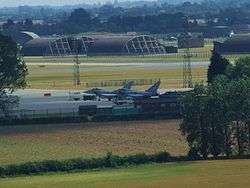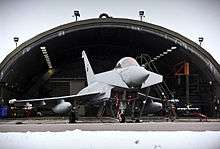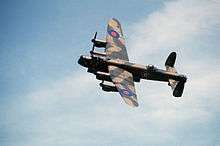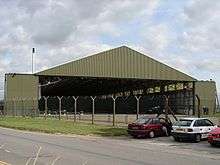RAF Coningsby
| RAF Coningsby | |||||||
|---|---|---|---|---|---|---|---|
| Near Coningsby, Lincolnshire in England | |||||||
 The airfield seen from Tattershall Castle | |||||||
 Loyalty binds me[1] | |||||||
 RAF Coningsby Shown within Lincolnshire | |||||||
| Coordinates | 53°05′35″N 000°09′58″W / 53.09306°N 0.16611°WCoordinates: 53°05′35″N 000°09′58″W / 53.09306°N 0.16611°W | ||||||
| Type | Royal Air Force station | ||||||
| Site information | |||||||
| Owner | Ministry of Defence | ||||||
| Operator | Royal Air Force | ||||||
| Controlled by | No. 1 Group (Air Combat) | ||||||
| Open to the public | Access to BBMF Hangar only | ||||||
| Website | http://www.raf.mod.uk/rafconingsby/ | ||||||
| Site history | |||||||
| Built | 1940 | ||||||
| In use | 1940–present | ||||||
| Garrison information | |||||||
| Current commander | Group Captain Mike Baulkwill.[2] | ||||||
| Occupants | |||||||
| Airfield information | |||||||
| Identifiers | IATA: QCY, ICAO: EGXC, WMO: 03391 | ||||||
| Elevation | 24 feet (7 m) AMSL | ||||||
| |||||||
Royal Air Force Coningsby or more simply RAF Coningsby (IATA: QCY, ICAO: EGXC), is a Royal Air Force station located 8.5 miles (13.7 km) south west of Horncastle, and 9.8 miles (15.8 km) north west of Boston, in the East Lindsey district of Lincolnshire, England.
The station is commanded by Group Captain Mike Baulkwill.
History
Second World War

RAF Coningsby was opened in 1940 as a bomber station.[3] No. 106 Squadron RAF arrived in February 1941 and No. 97 Squadron arrived in March 1941.[3] Hard runways were laid in early 1943 in preparation for heavy bombers being stationed, part of 5 Group.[4] No. 617 Squadron were at the station from August 1943 – January 1944.[5] Their officers' mess was the Petwood Hotel at Woodhall Spa. 61 Squadron were stationed with Lancasters from February–April 1944. On 12 November, 61 Squadron aircraft equipped with Tallboy bombs sank the Tirpitz in Operation Catechism. 175 aircraft were lost during the war.
Post war
Following the Second World War, it had the Mosquito-equipped 109 Sqn and 139 Sqn, then became part of 3 Group, with Boeing Washington aircraft from 1950. On 17 August 1953 52-year-old Air Vice-Marshal William Brook, the AOC of 3 Group, took off from the base in a Gloster Meteor, and crashed into a Dutch barn at Bradley, Staffordshire.
Jet aircraft
The airfield received its first jet aircraft—the English Electric Canberra—in 1953.[6] During 1956 the station expanded with the runway being extended.[6] Avro Vulcans arrived in 1962, which were transferred to RAF Cottesmore in November 1964.[6]
From 1964–66, the station had been initially designated to receive the proposed RAF fighter, the advanced BAC TSR-2 project,[6] which was cancelled for purported economic reasons in April 1965 by the Labour Government. The TSR2 was planned to join 40 Sqn at Coningsby in 1968 (the squadron had been disbanded with the Canberra at RAF Upwood in 1957). TSR = Tactical Strike Reconnaissance; it was a replacement for the successful Canberra.
Phantoms
The TSR2's intended replacement—the (American) General Dynamics F-111 Aardvark—was shelved on 16 January 1968[7] when its costs overshot the UK's budget (it would have cost £425m for 50 aircraft). The TSR2 had large development costs, whereas the F-111 (also known as Tactical Fighter Experimental, or TFX) could be bought off the shelf. Coningsby was planned to get the General Dynamics F-111K, the RAF version of the F-111; also in the 1966 Defence White Paper, it was intended that the Anglo-French AFVG, later the UKVG, would replace the TSR2 (it did eventually as the Tornado). 50 F-111Ks were planned with 100 AFVGs (to enter service by 1970); Denis Healey claimed the F-111s and AFVGs would be cheaper than the TSR2 programme (158 aircraft) by £700m. As Minister of Aviation throughout 1965, the Labour MP Roy Jenkins had also wanted to similarly cancel the Olympus-powered Concorde, but the 1962 Anglo-French treaty imposed prohibitive steep financial penalties for cancellation; the Hawker Siddeley P.1154 and HS.681 were cancelled at the same time.
After a parliament debate on 1 May 1967 about the prices of both F-111 and TSR2, Denis Healey simply wanted an aircraft programme that involved no research & development. Healey claimed that, over fifteen years, the TSR2 programme would cost £1,700m and the F-111 and AFVG would cost £1,000m—a large amount in 1965; none of the costings for these two figures were forthcoming, or how both numbers were arrived at, and could well have been fiction. AFVGs were also planned to replace the Buccaneer in the Royal Navy—Tornados were never were flown by the Royal Navy, as the carriers for them, the CVA-01s, were cancelled. But the Royal Navy did operate fourteen Phantoms on Ark Royal, until the new smaller carriers entered service—48 Phantoms had been designated for the Fleet Air Arm, with twenty of these ending up at Leuchars, and Ark Royal's Phantoms ended up at Leuchars in 1978. Eagle was never converted to Phantom use as it was deemed too expensive, and the carrier would simply be scrapped in January 1972, with its Sea Vixen aircraft. Another alternative considered by the Labour government in July 1965 for the TSR-2 was to order Spey-engined French Mirage IV aircraft, to be known as the Mirage IVS; it would have avionics from the TSR-2, and be partly made by BAC at Warton.[8]
Spey-engined Phantoms (the plane the government eventually bought, having been ordered in February 1964 for the Fleet Air Arm, instead of the P.1154) were chosen in 1966 for the station's future as with the scrapping of aircraft carriers the Phantoms were not needed for the Fleet Air Arm,[6] with all RAF Phantom training taking place on the airfield, and the station became part in Fighter Command[6] until December 1967, when it joined Air Support Command as the Phantoms were initially in a ground attack role. Phantoms first saw operational service with the Fleet Air Arm in 1970. The first Phantom FGR2 (Fighter/Ground attack/Reconnaissance) arrived at Coningsby on 23 August 1968, with the first aircrew OCU course (228 OCU) beginning in October 1968. Air-defence Phantoms (FG1) also entered service in 1969 at RAF Leuchars. On 18 May 1970, a Phantom flew from the base non-stop to RAF Tengah, covering 8,680 mi (13,970 km) in 14 hours and 14 minutes at an average speed of 602 mph (969 km/h). In April 1968, Strike Command was formed and the airfield was transferred to 38 Group.
41 Sqn joined in April 1972, and stayed until 1977. The other ground attack Phantom squadrons (four of them) were at RAF Bruggen. 111 Sqn replaced their Lightnings (from Wattisham) with Phantoms from 1 October 1974. On 1 January 1975, 29 Sqn joined and stayed until 1987, when disbanded. On 1 November 1975, 23 Sqn joined until February 1976, when moved to Wattisham. In March 1976, 56 Sqn joined until July 1976, then went to Wattisham.
The Phantom's role changed to air defence in October 1974 when the airfield transferred to 11 Group in RAF Strike Command, when the SEPECAT Jaguar (situated in Norfolk) took over the ground attack role. 111 Sqn were the first to take the new air defence Phantoms. During 1975, the UK's air defence transferred to the Phantom FGR.2 from five squadrons of Lightnings. The UK was covered by NATO Early Warning Area 12. Three Sector Operations Centres were at Buchan, Boulmer and Neatishead; in the 1960s, the UK had the Linesman/Mediator radar system, which was obsolete by the 1970s. No 29 Sqn formed with Phantoms at Coningsby on 1 January 1975; until then the Phantom FG.1 had been operating with the Royal Navy only. On 3 March 1975 a Phantom crashed into a nearby house, with both pilot and navigator ejecting. The Queen visited the station on 30 June 1976. Part of 228 OCU, 64 Sqn trained the navigators and instructors at the base; hardened aircraft shelters were built in 1981.
Tornados
.jpg)
The Tornado F3 squadrons began to form; 229 OCU (65 Sqn) trained on the Tornado from November 1984. [9] Tornado training took place until April 1987, when the Phantoms left (to RAF Leuchars) and Coningsby had the first (29 Sqn) Tornado air defence squadron.[10] To accommodate these new aircraft, extensive hardened aircraft shelters (HAS) and support facilities were built.[9] 5 Squadron arrived in January 1988; 5 Sqn had previously been on the Lightning.[11] The Tornado ADV carried the GEC-Marconi AI.24 Foxhunter radar.
During the Gulf War, Tornados from Coningsby were based for three months at Dhahran International Airport. Tornado engines were serviced on the northern section of the former RAF Woodhall Spa, denoted as RAF Woodhall.
Jaguars
6 Sqn flew the last of the RAF's Jaguar aircraft at Coningsby briefly from April 2006 to May 2007; it was stood down from RAF service on 30 April 2007.
Eurofighter Typhoon

Coningsby was the first airfield to receive the Phantoms,[6] the Tornado ADV[6] and was the first to receive its replacement, the Eurofighter Typhoon. 56 Squadron was posted here until March 2003 but relocated to RAF Leuchars and in 2008 to RAF Waddington to allow airfield improvements required for the arrival of the Typhoon. 5 Squadron also flew F3s from Coningsby until its disbandment in 2003 (this unit is now at Waddington). Typhoon arrived in May 2005 with No. 17 Squadron, after the RAF first publicly displayed the aircraft at Coningsby in December 2004. No 11 Squadron joined the station as a Typhoon unit in 2006.[12] In July 2007, the Typhoon became operational from the airfield (and the UK). The Typhoon also became operational from RAF Leuchars in September 2010. BAE Systems Military Air Solutions, who produce the aircraft, are also stationed on the airfield with the contract to maintain the aircraft.[13] On 1 July 2008, the Typhoon was declared by the RAF as being combat ready. The aeroplane, unlike the Tornado, needs no reheat to take off. RAF Coningsby is currently home to three front-line Eurofighter Typhoon squadrons; No. 3 Squadron, No. XI Squadron and No. 29 Squadron.
Role and operations
RAF Coningsby's mission statement is 'To develop the future, deliver the present and commemorate the past of the Royal Air Force's combat air power.'[14]
Typhoon operations

The Eurofighter Typhoon FGR4 provides the RAF with a multi-role combat capability for air policing, peace support and high intensity conflict. RAF Coningsby is the home to two front-line Typhoon units, No. 3(F) Squadron and No. 11 Squadron. They are accompanied by No. 29(R) Squadron which is the Typhoon Operational Conversion Unit which trains new crews.
The fourth Typhoon unit is No. 41 (Test and Evaluation) Squadron which is part of the Air Warfare Centre. The squadron develops operational tactics and evaluates new avionics and weapons systems. Formerly the Fast Jet and Weapons Operational Evaluation Unit (FJWOEU), it is a merger of the Strike/Attack OEU (previously based at MOD Boscombe Down), the Tornado F3 OEU (previously based at RAF Waddington) and the Air-Guided Weapons OEU (previously based at RAF Valley).
From 2019 the new joint No. 12 Squadron RAF will assist Qatari pilots training on the Typhoon, until a planned move to Qatar.
Quick Reaction Alert
Since June 2007 Coningsby’s Typhoons have been responsible for maintaining the Quick Reaction Alert (Interceptor) South mission (QRA(I)S). Aircraft and crews are held at a high state of readiness, 24 hours a day, 365 days a year, to respond to unidentified aircraft approaching UK airspace. QRA missions range from civilian airliners which have stopped responding to air traffic control, to intercepting Russian aircraft such as the Tupolev Tu-95 Bear and Tu-160 Blackjack.
Battle of Britain Memorial Flight
%2C_Coningsby_-_geograph.org.uk_-_817198.jpg)
Coningsby has been home of the Battle of Britain Memorial Flight (BBMF) and the associated visitor centre since March 1976 when it arrived from RAF Coltishall.[6][15] The BBMF operate one of two remaining airworthy Avro Lancaster bombers in the world, alongside; six Spitfires of various types; two Hurricanes; a Dakota and two Chipmunks, the latter type being used for pilot training.
The BBMF is accessed via a separate entrance to the main base, with a car park, to the west of the airfield. The memorabilia display is free but there is a small charge for the hour-long guided tour around the hangar.
Expeditionary Air Wing
No. 121 Expeditionary Air Wing was formed at Coningsby on 1 April 2006 and encompasses most of the non-formed unit personnel. The EAW does not include any of the flying squadrons. The Station Commander also commands the EAW.
Based units

Flying and major non-flying units based at RAF Coningsby.[16][17][18]
Royal Air Force
- Typhoon Force
- Typhoon Force Headquarters
- No. 3 Squadron – Typhoon FGR4
- No. 11 Squadron – Typhoon FGR4
- No. 29 Squadron – Typhoon FGR4
- Typhoon Display Team
- Battle of Britain Memorial Flight (BBMF) – Spitfire, Hurricane, Lancaster, Dakota and Chipmunk.
No. 2 Group (Air Combat Support) RAF
- No. 7 RAF Force Protection Wing
- No. 7 Force Protection Wing Headquarters
- No. 8 RAF Force Protection Wing
- No. 5 RAF Police Squadron
- No. 41 TES (Test and Evaluation Squadron) – Typhoon FGR4
The deployable elements of the station structure form the core of No. 121 Expeditionary Air Wing.[19]
British Army
Royal Engineers (8 Engineer Brigade, 170 Engineer Group, 20 Works Group Royal Engineers (Air Support)
- 532 Specialist Team Royal Engineers (Airfields) (STRE)
Incidents and accidents
- 1974 Norfolk mid-air collision: On 9 August 1974, the station commander 42-year-old Group Captain David Blucke, and his navigator Flight Lieutenant Terence Kirkland (aged 28 and from Londonderry), were killed whilst piloting the Phantom XV493 of 41 Sqn. At low-level it hit a Piper Pawnee crop-spraying plane (from Southend-on-Sea) over Fordham, Norfolk, near Downham Market. Blucke was son of Air Vice-Marshal Robert Blucke who was known for the 1935 Daventry Experiment.
Station Commanders

- Air Chief Marshal Sir Augustus Walker GCB 1951–1954
- Air Commodore David Strong CB 1957–59
- Air Vice-Marshal Michael Le Bas CB CBE DSO AFC 1959–1961
- Air Vice-Marshal Frank Dodd CBE DFC 1961–1963
- Air Chief Marshal Sir John Rogers KCB CBE 1967–1969
- Group Captain David Robert Kidgell Blucke ?-1974
- Air Vice-Marshal Dennis Allison CB 1974–1976
- Air Vice-Marshal Derek Bryant CB OBE 1976–1978
- Group Captain Christopher Sprent 1978–80
- Air Chief Marshal Sir William Wratten CBE CB 1980–1982
- Air Commodore Robert (Bob) Arnott CBE 1982–1984
- Group Captain Mike Elsam 1984–1986
- Air Marshal Sir Christopher Coville CB 1986–1988
- Air Marshal Clifford Spink CB CBE 1990–1993
- Air Vice-Marshal Peter Ruddock CBE 1999–2000
The following Station Commanders are listed in the rank held at the time of appointment:
- Group Captain Bob Judson (2004–2006)
- Group Captain Stuart Atha DSO (2006–2008)
- Group Captain J J Hitchcock (2008–2010)
- Group Captain Martin Sampson DSO (2010–2012)
- Group Captain Johnny Stringer (2012–2014)
- Group Captain Jez Attridge OBE (2014–2016)
- Group Captain Mike Baulkwill (2016–Present)
See also
References
Citations
- ↑ Pine, L.G. (1983). A dictionary of mottoes (1 ed.). London: Routledge & Kegan Paul. p. 131. ISBN 0-7100-9339-X.
- ↑ retrieved 15 September 2017
- 1 2 Halpenny, Bruce Barrymore Action Stations: Wartime Military Airfields of Lincolnshire and the East Midlands v. 2, page 64
- ↑ 5 Group Archived 6 April 2011 at the Wayback Machine.
- ↑ Halpenny, Bruce Barrymore Action Stations: Wartime Military Airfields of Lincolnshire and the East Midlands v. 2. Page ?
- 1 2 3 4 5 6 7 8 9 Halpenny, Bruce Barrymore Action Stations: Wartime Military Airfields of Lincolnshire and the East Midlands v. 2. Page 67.
- ↑ Hansard March 1968
- ↑ Hansard December 1965
- 1 2 Halpenny, Bruce Barrymore Action Stations: Wartime Military Airfields of Lincolnshire and the East Midlands v. 2. Page 221.
- ↑ Halpenny, Bruce Barrymore Action Stations: Wartime Military Airfields of Lincolnshire and the East Midlands v. 2. Page 222.
- ↑ http://www.tornado-data.com/History/timeline.htm Tornado Data
- ↑ RAF Coningsby squadrons retrieved 29 December 2008
- ↑ http://news.bbc.co.uk/1/hi/england/lincolnshire/7923988.stm BAE Systems maintenance contract
- ↑ "About us". RAF Coningsby. Retrieved 15 January 2018.
- ↑ Battle of Britain Memorial Flight Visitor Centre
- ↑ "RAF Coningsby – Who's Based Here". Royal Air Force. Retrieved 14 July 2018.
- ↑ "An introduction to...20 Works Group Royal Engineers" (PDF). Wittering View. Lance Publishing Ltd.: 18 Spring 2015.
- ↑ "RAF Police – Force Protection – Squadrons and Units". Royal Air Force. Retrieved 14 July 2018.
- ↑ "121 Expeditionary Air Wing Training". Royal Air Force. 17 September 2015. Archived from the original on 2018-01-01. Retrieved 16 July 2017.
- ↑ "RAF Regiment Association Official Site". Rafregt.org.uk. Archived from the original on 2 February 2009. Retrieved 15 October 2008.
Bibliography
- Bruce Barrymore Halpenny Action Stations: Wartime Military Airfields of Lincolnshire and the East Midlands v. 2 (updated version) ( ISBN 978-1852604059)
External links
| Wikimedia Commons has media related to RAF Coningsby. |
- RAF Coningsby
- RAF Lincolnshire
- Viewing guide
- Airport information for EGXC at World Aero Data. Data current as of October 2006.
News items
- Flyover rehearsal in April 2011
- 70th anniversary in March 2011
- 1,000 flying hours in a Typhoon in November 2009
- Typhoon fully combat ready in July 2008
- Typhoons began active service in July 2007
- First Typhoon squadron in April 2006
- Report by Brian Hanrahan in October 2005.
- Typhoons arrive in May 2005
- 5 Squadron mothballed in February 2002
- 56 Squadron moves to Leuchars in January 2002
- Tornado crash narrowly missed Torness nuclear power station in November 1999.

